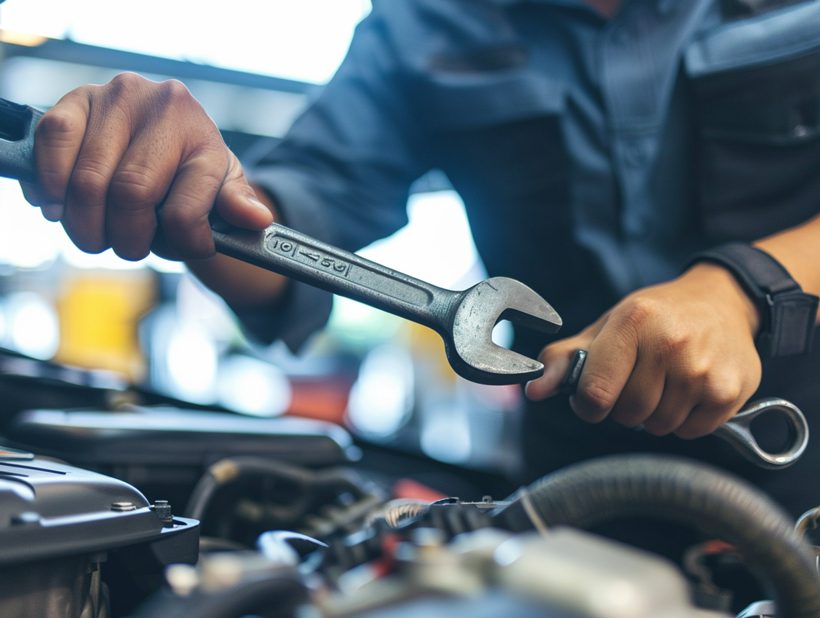Ever found a suspicious puddle under your car and wondered, “Why’s my car leaking oil?” You’re not alone. Oil leaks can be a real headache, signaling potential trouble under the hood. I’ll help you get to the bottom of this slippery issue.
Spotting oil stains on your driveway can be alarming. But don’t worry, I’ve got the inside scoop on identifying common engine oil leaks. Understanding the ‘why’ and ‘where’ is key to keeping your car running smoothly.
What Causes Oil Leaks in Cars?

When I’m under the hood examining an engine, one of the most common issues I come across is oil leaks. It’s not just a messy inconvenience; oil leaks can lead to serious engine damage if they’re not addressed promptly. But what exactly causes these leaks? Let’s dive into the primary reasons why cars begin to drip that all-important lubricant.
- Worn Engine Gaskets: The gaskets in an engine are designed to keep fluids in and contaminants out. Over time, these can wear down, harden, or break, especially the head gasket, which is often the culprit in major oil leaks.
- Oil Pan Damage: The oil pan and its accompanying gasket can suffer from corrosion or physical damage, creating a direct path for oil to escape. Rough roads and debris can sometimes inflict punctures or tears.
- Improper Oil Changes: Sometimes the simplest actions cause complications; not replacing the oil filter properly or over-tightening the oil drain plug during an oil change can lead to leaks.
- Age and Mileage: As a car ages and racks up mileage, seals and gaskets may deteriorate, losing their elasticity and effectiveness. It’s a natural part of a car’s lifecycle.
- Faulty Oil Cap Seal: A cracked or faulty oil cap can’t maintain the necessary pressure in the crankcase, inviting leaks both small and pronounced.
- High Pressure Within Engine: Occasionally, blocked or malfunctioning oil passages increase pressure, forcing oil through weakened seals or gaskets.
Behind these common causes lies a complex network of interdependent components, each with a potential for wear and tear. Regular maintenance is the key to keeping these issues at bay and ensuring the longevity of an engine. Detecting the source of a leak early can save significant time and money, and by knowing what to look for, I’m better equipped to prevent minor problems from turning into major headaches. Remember, the health of a car depends significantly on the proper maintenance of its systems, leaving no room for neglect when it comes to potential oil leaks.
Common Signs of Engine Oil Leaks
When it comes to ensuring my car’s longevity and performance, spotting signs of engine oil leaks early can save me from costlier repairs down the road. Here’s what I’ve learned to look for:
Dark Puddles Under the Car
I’ve noticed that one of the most apparent signs is finding dark puddles or spots on the ground where I park. These are usually indicative of oil, which can be confirmed by the slick texture and brownish-black color.
Smoke from the Engine Area
If there’s smoke emanating from the engine area, it’s a red flag. It often means oil is dripping onto hot engine parts and burning away, producing smoke.

Engine Overheating
Oil plays a crucial role in cooling the engine. When levels drop due to a leak, I may notice my engine runs hotter than usual.
Low Oil Levels
Regularly checking my oil dipstick, I look out for lower than normal oil levels. Should I need to top off oil more frequently, it’s a telltale sign of a leak.
Oil Warning Light
My car’s dashboard oil light is a straightforward indicator. When it illuminates, it’s imperative to check the oil level and inspect for leaks.
Recognizing these signs promptly means taking swift action. To help pinpoint the source, here are a few places I check for leaks:
- Around the oil filter and oil drain plug
- Along oil cooler lines
- At the valve cover gasket
By staying vigilant and addressing oil leaks as soon as they’re spotted, I’m able to mitigate potential engine damage and maintain my car’s performance. Regular inspections are part of my routine to ensure oil isn’t seeping out where it shouldn’t.
Understanding Different Types of Oil Leaks
When dealing with car maintenance, identifying the nature of an oil leak is crucial. These leaks, often insidious, can manifest in several distinct forms. Let’s delve into the most common ones.

Gasket Leaks
Gaskets are the seals between two metal parts in the engine, and they’re prime suspects for oil leaks. Degradation over time, due to exposure to extreme temperatures and engine pressure, can lead to oil escaping through these wear points. Key gaskets to monitor include:
- Valve Cover Gaskets: Located atop the engine, these seals can harden and crack.
- Oil Pan Gaskets: Found at the bottom of the engine, they can succumb to rough roads and debris.
- Head Gaskets: These are critical seals between the engine block and cylinder head; failure here can be serious.
Seal Leaks
Seals are another common culprit behind oil leaks. Unlike gaskets, seals are used to close off the ends of parts that move or rotate, and they can wear down from motion and heat. Notable seals prone to leaking include:
- Crankshaft Seals: Positioned at the front and rear of the crankshaft, these serve high-motion areas.
- Camshaft Seals: Like the crankshaft seals, they’re subjected to rotation and can deteriorate.
Other Common Leak Sources
Aside from gaskets and seals, oil can find escape routes through other weak spots:
- Oil Filter: An improperly fitted filter or one with a failed seal can drip oil.
- Drain Plug: Located at the base of the oil pan, a loose or worn-out plug can slowly leak oil.
Regular check-ups can spot these issues before they exacerbate. For preventive measures, I recommend getting your vehicle inspected during oil changes; this is when a trained eye can catch early signs of wear. Keeping an eye on the health of your gaskets and seals is key, as well as ensuring components like the oil filter and drain plug are correctly installed and in good condition. Timely replacements and fixes will save you both time and money in the long run, not to mention the peace of mind knowing your car is in top shape.
How to Identify the Source of an Oil Leak
When I’m faced with an unexplained oil leak, my first step is to pinpoint the source. This process can feel daunting, but with a methodical approach, it’s definitely manageable. I usually start by cleaning the engine. A clean engine makes it easier to track fresh oil and find the leak. Here’s my step-by-step guide:
- Check for Visual Clues: After I’ve cleaned the engine, I’ll start the car and let it run for a few minutes. This will cause fresh oil to seep out, providing a clear indication of where the problem might be.
- Inspect Common Leak Points: I make sure to inspect the areas I already know are prone to leaks, like the valve cover gaskets, oil pan gaskets, and various engine seals.
- Use Leak Detection Dye: Sometimes, the origin of the leak isn’t obvious. When that happens, I add a fluorescent dye to the oil that’s visible under UV light. This can be extremely helpful in tracing the exact path the oil takes.
- Check the Oil Filter and Drain Plug: It’s not unusual for the oil filter or the drain plug to be the culprit. They can become loose or their seals might degrade over time.
- Monitor Oil Levels: Keep an eye on the oil level. A drastic drop usually means a significant leak, whereas a gradual decrease might indicate a minor one.

If the leak is small and the location elusive, I might use the following table to keep track of possible sources and their investigation status:
| Potential Source | Inspection Status | Notes |
|---|---|---|
| Valve Cover Gasket | Checked; No Leak | |
| Oil Pan Gasket | To Be Checked | Access might require lifting the car |
| Crankshaft Seal | Checked; Leak Found | Scheduled for repair |
| Camshaft Seal | To Be Checked | |
| Oil Filter | Checked; No Leak | Replaced as precaution |
| Drain Plug | Checked; Leak Found | Washer replaced |
By following these steps and maintaining a record of my findings, I’m able to stay on top of the situation and prioritize my repair tasks. It’s a methodical way to ensure nothing gets overlooked and that I’m addressing the most urgent issues first.
Steps to Fix an Engine Oil Leak
Identifying an engine oil leak is only the first step in addressing the issue. Once you’ve pinpointed the source, it’s time to get your hands dirty and fix the problem. I’ll walk you through the process, ensuring that each step is manageable, even for those who aren’t mechanically inclined.
Before starting repairs, make sure you’ve got the right tools and replacement parts specific to your car’s make and model. You might need new gaskets, seals, or washers. Having everything on hand will make the job smoother.

Perform a Gasket and Seal Replacement
- Turn off the engine and ensure it’s cool before you begin any work.
- Remove any components blocking access to the leaking gasket or seal.
- Carefully take out the old gasket or seal, making sure not to leave any residue that could prevent a good seal.
- Apply gasket sealant if recommended by your vehicle manufacturer.
- Install the new gasket or seal, tightening bolts to the specified torque to avoid overtightening which can cause additional leaks.
Tighten or Replace the Oil Filter and Drain Plug
If the leak is from the oil filter or drain plug, the solution might be simpler than you think:
- For an oil filter:
- For the drain plug:
Use Leak Repair Additives
As a temporary fix, especially if you’re not able to perform a permanent repair right away, consider using a leak repair additive. These additives can recondition seals and gaskets to temporarily stop small leaks. However, it’s best to view this as a short-term solution; the underlying issue should still be addressed as soon as possible. Always check your vehicle’s manual before adding any additives to ensure compatibility.
Remember to religiously monitor your oil levels and check for leaks after conducting repairs. This vigilance ensures that your efforts haven’t been in vain and safeguards your engine from potential damage due to low oil levels.
Conclusion
Tackling an oil leak in your car is no small feat but armed with the right knowledge and tools you can address this issue head-on. Remember to match replacement parts to your car’s specifications and to handle gasket or seal replacement with care. If you’re in a pinch, leak repair additives might help but they’re not a permanent fix. After any repairs keep a vigilant eye on your oil levels and look out for any signs of new leaks. With these tips, you’re well on your way to ensuring your car runs smoothly and remains leak-free. Stay proactive and your vehicle will thank you with reliable performance and longevity.
